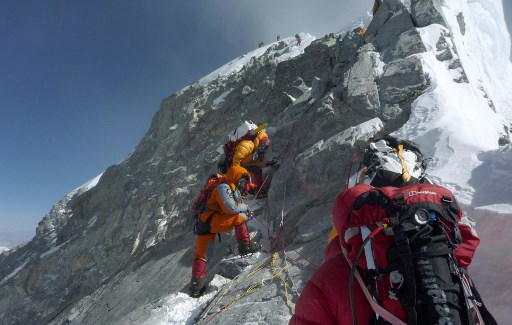
by Annabel Symington
Agence France Presse
KATHMANDU, Nepal (AFP) — Mount Everest’s Hillary Step — a rocky outcrop just below the summit — is now a slope, say climbers who recently returned from the mountain.
The condition of the rock face named after Everest’s first summiteer Edmund Hillary has been the subject of intense speculation since climbers last year declared it had gone. Others disagreed saying fresh snowfall had caused the confusion.
Mountaineers returning from the summit this month have unanimously said that what was once a near-vertical 12 meter (40 feet) rock face is now a gradual snowy slope and makes the final ascent quicker and easier.
“The Hillary Step is not like we’ve known it to be,” said Nepali guide Dawa Phinjo Lama Bhote, one of seven climbers AFP spoke to.
“A big stone of about five meters is gone. The area is now easier to climb,” added the seven-time Everest summiteer.
The step formed part of a narrow, exposed ridge connecting Everest’s south summit (8,749 meters) with the true summit (8,848 meters).
Hillary and Tenzing Norgay famously scrambled up the sheer step in 1953 when they became the first climbers to conquer Everest.
Since that first successful summit, all climbers summiting Everest via the southern route have used ropes to pull themselves up the formidable obstacle, before swinging one leg over a “saddle” at the top.
But straddling the top boulder and shuffling along the precipice is no longer necessary.
“The Hillary Step has changed. We now climb it on the right-hand side going up a snow slope,” said British climber Kenton Cool, who made his 13th summit of Everest last week.
“It clearly doesn’t have the little corner between the snow and the rock that used to be there. There’s not the rock on the top of the step that you used to go ‘à cheval’ (straddle) and shuffle along.”
Easier and faster
Climbers say the disappearance of the step has left little more than an undulating ridge to the summit.
“The area of the Hillary’s Step is a moderately steep snow ridge, but does not stand out more prominently than any other section between the south summit and main summit,” said a climber who declined to be named.
Climbers began speculating in 2016 that a powerful earthquake in Nepal the year before could have radically altered the step.
Geologists, however, have questioned if the 7.8-magnitude earthquake was powerful enough to shift rocks near Everest’s summit, which stands 450 kilometers (280 miles) east of the epicenter.
Climate change has emerged as another possible culprit. Some peaks in Europe’s Alps have been dramatically altered by warming temperatures as ice has repeatedly melted and refrozen, loosening rock and causing landslides.
But Dr Jeffrey Kargel of the US-based Planetary Science Institute said Everest’s extreme altitude would protect the Step from such a “freeze-thaw” cycle.
“It is far too cold near Everest’s summit, even on sunny summer days and (at) high noon,” said the climate change scientist, leaving the question of what has happened to the fabled rock hanging.
Nepali authorities — who make millions from climbers paying to ascend Everest each year — last year insisted it remained unchanged.
Head of Nepal’s tourism department Dinesh Bhattarai this year stood by that claim, saying: “I have not heard anything different this year.”
Meanwhile, climbers told AFP they were instructed by the department not to speak to the press about the fabled step, and warned they could face a mountaineering ban if they did.
© Agence France-Presse







